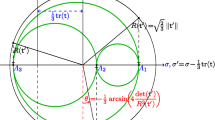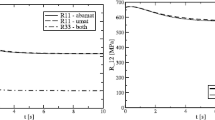Abstract
The objective of this paper is to generalize an Ogden-type model for elastically isotropic response to include elastic-viscoplastic response. The proposed model uses a strain energy function that depends on the total dilatation and the maximum and minimum elastic distortional stretches. A novel feature of the model is that these elastic distortional stretches are expressed in terms of two independent invariants of an elastic distortional deformation tensor that is determined by an evolution equation. The Cauchy stress is determined by derivatives of the strain energy function, the dilatation and the elastic distortional deformation tensor without the need for determining its principal directions. Examples demonstrate the response of the model for hyperelastic response but the proposed formulation can also model a smooth elastic-plastic transition with rate-independent or rate-dependent response with hardening.







Similar content being viewed by others
References
Blaise, B.B., Betchewe, G., Beda, T.: Optimization of the model of Ogden energy by the genetic algorithm method. Appl. Rheol. 29(1), 21–29 (2019)
Eckart, C.: The thermodynamics of irreversible processes. IV. The theory of elasticity and anelasticity. Phys. Rev. 73, 373–382 (1948)
Flory, P.J.: Thermodynamic relations for high elastic materials. Trans. Faraday Soc. 57, 829–838 (1961)
Fung, Y.: Biomechanics-Mechanical Properties of Living Tissues, 2nd edn. Springer, Berlin (1993)
Hollenstein, M., Jabareen, M., Rubin, M.B.: Modeling a smooth elastic–inelastic transition with a strongly objective numerical integrator needing no iteration. Comput. Mech. 52, 649–667 (2013)
Hollenstein, M., Jabareen, M., Rubin, M.B.: Erratum to: Modeling a smooth elastic–inelastic transition with a strongly objective numerical integrator needing no iteration. Comput. Mech. 55, 453 (2015)
Leonov, A.I.: Nonequilibrium thermodynamics and rheology of viscoelastic polymer media. Rheol. Acta 15, 85–98 (1976)
Ogden, R.W.: Non-linear Elastic Deformations. Courier Corporation, ??? (1997)
Rubin, M.B.: Continuum Mechanics with Eulerian Formulations of Constitutive Equations. Springer, ??? (2021)
Rubin, M.B., Attia, A.V.: Calculation of hyperelastic response of finitely deformed elastic-viscoplastic materials. Int. J. Numer. Methods Eng. 39, 309–320 (1996)
Rubin, M.B., Ehret, A.E.: An invariant-based Ogden-type model for incompressible isotropic hyperelastic materials. J. Elast. 125(1), 63–71 (2016)
Author information
Authors and Affiliations
Contributions
Both authors contributed equally to all aspects of the manuscript
Corresponding author
Ethics declarations
Competing interests
The authors declare no competing interests.
Additional information
Publisher’s Note
Springer Nature remains neutral with regard to jurisdictional claims in published maps and institutional affiliations.
Appendices
Appendix A: Bounds
Consider the function
for which
These results can be used to determine that \(x_{1}=x_{3}=1\) yields the minimum value of \(f\) with
Next, using the spectral form of \({\mathbf {B}_{e}^{\prime}}\), it follows from (4) that
Then, using (12), it can be shown that
Furthermore, it can be numerically shown that
which prove the results (18).
Appendix B: Details of Some Derivatives
With the help of (28) it can be shown that
Moreover, using (31), it follows that
Again, using (31), it follows that
which can be used to deduce that
Rights and permissions
Springer Nature or its licensor (e.g. a society or other partner) holds exclusive rights to this article under a publishing agreement with the author(s) or other rightsholder(s); author self-archiving of the accepted manuscript version of this article is solely governed by the terms of such publishing agreement and applicable law.
About this article
Cite this article
Rubin, M.B., Heiduschke, K. A Generalized Ogden-Type Elastically Isotropic Hyperelastic Model Including Elastic-Viscoplastic Response. J Elast 153, 359–372 (2023). https://doi.org/10.1007/s10659-023-09995-8
Received:
Accepted:
Published:
Issue Date:
DOI: https://doi.org/10.1007/s10659-023-09995-8




